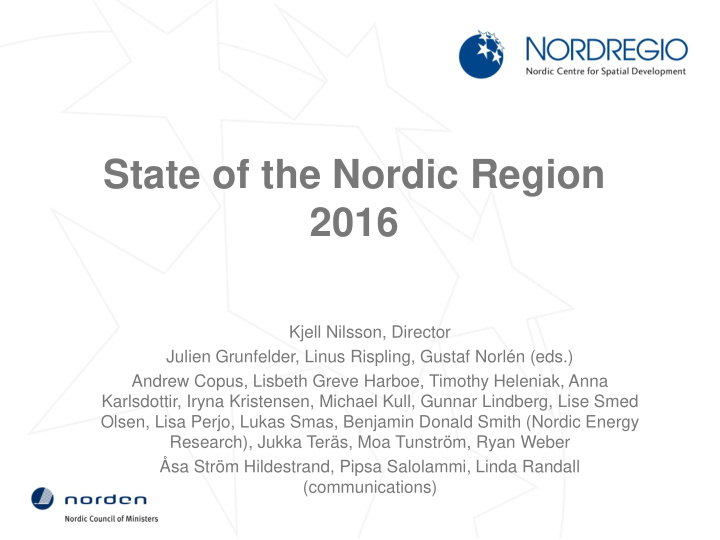



State of the Nordic Region 2016 Kjell Nilsson, Director Julien Grunfelder, Linus Rispling, Gustaf Norlén (eds.) Andrew Copus, Lisbeth Greve Harboe, Timothy Heleniak, Anna Karlsdottir, Iryna Kristensen, Michael Kull, Gunnar Lindberg, Lise Smed Olsen, Lisa Perjo, Lukas Smas, Benjamin Donald Smith (Nordic Energy Research), Jukka Teräs, Moa Tunström, Ryan Weber Åsa Ström Hildestrand, Pipsa Salolammi, Linda Randall (communications)
Demographic change: Challange or opportunity The population of the Nordic Region has increased by 2.7 million in the past 20 years and now stands at about 26.5 million - 0.63% per year (40 % faster than EU average) Iceland & Norway ˃ 1 % Sweden ̴ Nordic average Denmark & Finland ̴ EU Faroe Islands & Greenland 0 Territorial unbalance: Over 97 % has been absorbed by the 30 largest Functional Urban Areas Net-immigration accounted for two thirds of the total Nordic population increase over the past 25 years (three quarters in Sweden, Denmark and Åland)
Old-age Dependency Dependency ratios show the proportion of the population which are outside the normal working age, and therefore dependent upon the economic activity and tax paying capacity of others Old age dependency rates are rising across the Nordic countries (and much of the Western World), but are particularly high in remote rural municipalities as younger members of the population drift towards urban and urban adjacent municipalities However, since 2010 old age dependency rates in more accessible rural areas have outstripped those of the remote rural municipalities Men out-number women everywhere but in urban areas
Employment The Nordic labour market has recovered well overall from the Global Financial Crisis, though unemployment rates are concerning in several regions of Denmark, Finland and Sweden The Nordic average employment rate in 2014 was 73.4 % for the population aged 15-64 years, compared to the EU average of 64.9 % Iceland experienced the sharpest drop following the Global Financial Crisis but is now one of the strongest performers with an employment rate well above the Nordic average Employment rates in the capitals and most of the bigger cities are comparable to the Nordic average with the exception of Malmö, which has an employment rate under the EU average Especially the rural municipalities in eastern and northern Finland have low employment rates, under EU average Compared to mainland Finland Åland sticks out with high employment rates – 79,3 % Municipalities close to Copenhagen – Allerød, Egedal, Dragør, Hørsholm have employment rates around 80 %, while Odense, Langeland, Svendborg and Nyborg in Syddanmark are among the municipalities with lowest employment rates in Denmark. (~65-69 %) .
Youth unemployment Youth unemployment rate (15-24 years), 2005-2014 Youth unemployment in Norway and Iceland 30 is strikingly low In particular regions in Sweden have high 25 unemployment. One reason for the high youth unemployment in Sweden is because the systems of apprenticeship differ between 20 the countries In 2013 the highest youth unemployment in 15 % Denmark was in the different municipalities in the Capital region (on average 14.5%) 10 The youth unemployment in Finland varies across regions but is high in many municipalities and in some cases exceeds 5 the alarming levels that have been associated with Southern Europe. This 0 applies for municipalities with higher 2005 2006 2007 2008 2009 2010 2011 2012 2013 2014 unemployment rate than 32% and up to 45% Sweden EU28 Finland Denmark Iceland Faroe Islands Norway like, Rautjärvi in South Karelia, Pyhtää in Kymmeneda, Pätäjävesi and Jämsä in Middle Finland, Orivesi and Akaa in Birkaland, Kemi and Kemijärvi in Lappland, Kustavi in Varsinais Suomi and Hanko in Nyland
Educational level among 30-34 – year-olds At national level, in the Nordic region, the Europe 2020 headline target of 40% was by 2014 met in all five Nordic countries. The highest education levels, above 40% (indicated by the blue hues), among 30-34 – years-olds, to a large extent can be found in either university cities, or in socio- economically strong municipalities in metropolitan areas The Nordic average is a striking 15.1% unit difference between men and women in favour of the women - No single region within the Nordics has a higher share of highly educated men than females in the ages 30-34
Economic performance Urban and capital city regions show high levels of GDP per capita, as is the well-known pattern throughout Europe Stockholm, Oslo, Copenhagen and western Norwegian regions are among the wealthiest in Europe The Swedish and Norwegian northern regions are all performing well in relation to the European average The economies in the top-performing small regions are usually thriving thanks to a large, single industry often highly specialised internationally: in Åland, the transport sector; in Norrbotten, mining; and in Northern Norway, oil exploitation and fisheries Greenland and the Faroe Islands are also above the European average (for Greenland though, Danish subsidies supply roughly 60 % government revenue and 40 % of Greenland's GDP)
Change in real Gross Regional Product (GRP) 2009 – 2013 Sweden has seen increases in GRP for all regions of more than 4 % (but some regions suffered rather severely from low GRP in 2008 and 2009 and therefore have made great recoveries) In Iceland and Norway the picture is equally strong In Denmark the regions of Nordjylland , Midtjylland , Syddanmark and Hovedstaden have all suffered from an average of reduced annual GRP throughout this period In Finland the situation is even more severe in Varsinais-Suomi where GRP has on average decreased between 1 – 2 percent. In Uusimaa (Helsinki) and Keski-Suomi the reduction is more moderate, between 0 - 1 percent Greenland has on average seen GRP increases between 1 – 2 %, as have Åland
www.nordregio.se www.nordmap.se
Recommend
More recommend